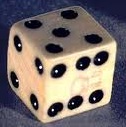Probability and Statistics > Probability > Mutually Exclusive Events
What is a Mutually Exclusive Event?
Mutually exclusive events are things that can’t happen at the same time. For example, you can’t run backwards and forwards at the same time. The events “running forward” and “running backwards” are mutually exclusive. Tossing a coin can also give you this type of event. You can’t toss a coin and get both a heads and tails. So “tossing a heads” and “tossing a tails” are mutually exclusive. Some more examples are: your ability to pay your rent if you don’t get paid, or watching TV if you don’t have a TV.

Watch the video for the definition and two examples of finding probabilities for mutually exclusive events:
Mutually Exclusive Event Probability
The basic probability(P) of an event happening (forgetting mutual exclusivity for a moment) is:
P = Number of ways the event can happen / total number of outcomes.
Example: The probability of rolling a “5” when you throw a die is 1/6 because there is one “5” on a die and six possible outcomes. If we call the probability of rolling a 5 “Event A”, then the equation is:
P(A) = Number of ways the event can happen / total number of outcomes
P(A) = 1 / 6.

The events are written like this:
P(A and B) = 0
In English, all that means the probability of event A (rolling a 5) and event B (rolling a 6) happening together is 0.
However, when you roll a die, you can roll a 5 OR a 6 (the odds are 1 out of 6 for each event) and the sum of either event happening is the sum of both probabilities. In probability, it’s written like this:
P(A or B) = P(A) + P(B)
P(rolling a 5 or rolling a 6) = P(rolling a 5) + P(rolling a 6)
P(rolling a 5 or rolling a 6) = 1/6 + 1/6 = 2/6 = 1/3.

Mutually Exclusive Event PRobability: Steps
Example problem: “If P(A) = 0.20, P(B) = 0.35 and (P A∪ B) = 0.51, are A and B mutually exclusive?”
Note: a union (∪) of two events occurring means that A or B occurs.
Step 1: Add up the probabilities of the separate events (A and B). In the above example:
.20 + .35 = .55
Step 2: Compare your answer to the given “union” statement (A ∪ B). If they are the same, the events are mutually exclusive. If they are different, they are not mutually exclusive. Why? If they are mutually exclusive (they can’t occur together), then the (∪)nion of the two events must be the sum of both, i.e. 0.20 + 0.35 = 0.55.
In our example, 0.55 does not equal 0.51, so the events are not mutually exclusive.
References
Beyer, W. H. CRC Standard Mathematical Tables, 31st ed. Boca Raton, FL: CRC Press, pp. 536 and 571, 2002.
Dodge, Y. (2008). The Concise Encyclopedia of Statistics. Springer.
Everitt, B. S.; Skrondal, A. (2010), The Cambridge Dictionary of Statistics, Cambridge University Press.
Wheelan, C. (2014). Naked Statistics. W. W. Norton & Company